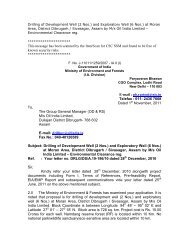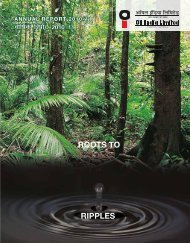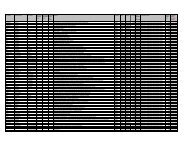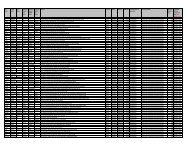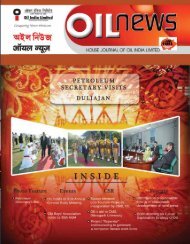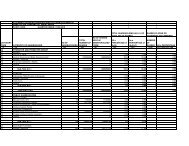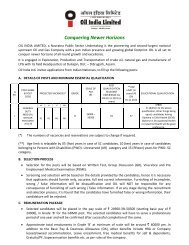2005 - Oil India Limited
2005 - Oil India Limited
2005 - Oil India Limited
Create successful ePaper yourself
Turn your PDF publications into a flip-book with our unique Google optimized e-Paper software.
OIL beyond territorial barriers<br />
MERGERS AND ACQUISITIONS:<br />
PROCESSES<br />
Acquisition could be acquiring an<br />
asset or acquiring stocks in a<br />
company. The latter could be with<br />
management control or without<br />
management control. An acquired<br />
asset could be managed by the<br />
acquiring company as a division or<br />
as a subsidiary. Similarly, an<br />
acquired company could be<br />
managed either as a separate entity<br />
or it could be merged with the<br />
acquirer by consolidating the<br />
accounts. In the later event, the<br />
acquired company loses its identity.<br />
The share holders of the acquired<br />
company are offered equity shares in<br />
the acquiring company as per ratios<br />
mutually agreed upon.<br />
Acquisition of an asset or a company stock has a cost<br />
attached to it. Therefore, acquisition makes sense to the<br />
acquirer only when it can add value to the acquired entity<br />
through injection of fresh capital and technology, resulting<br />
in modernization of plants and machineries, or through<br />
improved management including organizational<br />
re-structuring or more often by synergizing the operations<br />
of the acquired entity with those of the<br />
acquired company.<br />
For expansion in the same business<br />
segment, one of the means is through<br />
fresh capital investment. For an E & P<br />
company like <strong>Oil</strong> <strong>India</strong> <strong>Limited</strong>, this<br />
means bidding for exploration blocks<br />
and going through the entire activity<br />
chain consisting of geological<br />
analysis, geophysical surveys,<br />
exploratory drilling, appraisal of<br />
discovery, preparation of<br />
development plan, development drilling and creation of<br />
surface facilities before production and revenue<br />
generation starts. The long chain<br />
of activities normally takes 7 years<br />
or more. In addition, there is the<br />
risk of several of the exploration<br />
ventures being a failure.<br />
To cut short this time span and also<br />
to reduce the risk, the E & P<br />
companies seeking growth in the<br />
same business segment resorts to<br />
M & A activities of acquiring<br />
discovered fields awaiting<br />
development or producing<br />
properties. This also provides an<br />
opportunity to the oil company of<br />
diversifying the locations of the<br />
acreage held by it to spread the<br />
overall risk (eg. political risk).<br />
It is needless to state that such a<br />
business strategy of expediting<br />
growth would need availability of excess cash. The<br />
company would need to create what is called a `war<br />
chest' for acquisition. It is because trying to raise money<br />
from the capital market as equity or debt at the time of<br />
acquisition could be self-defeating on several counts. For<br />
example, tight time schedule for acquisition may not<br />
permit a judicious choice of funding options. Information<br />
on the entity to be acquired including its valuation may<br />
get circulated before the submission<br />
of the final binding bid to the<br />
advantage of the competitor. Once<br />
the buyer-seller agreement is final,<br />
capital could be raised from the<br />
market to complete the transaction<br />
and the war chest could be kept<br />
intact or replenished for future<br />
acquisitions.<br />
While considering an E & P<br />
acquisition, the acquirer must take<br />
into account the up-side potential<br />
of the entity. The up-side potential could be additional<br />
reserves accretion from extension of the productive limit<br />
5




